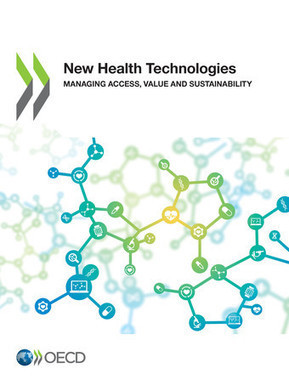New Health Technologies. Managing Access, Value and Sustainability
This new OECD report sheds light over several issues in an heterogeneous way, but the pharma chapter has a box that I want to highlight. It is really suggestive:
Future scenarios about drug development and drug pricing
These disruptive scenarios result from an expert consultation led by ShiftN and commissioned by the Belgian Health Care Knowledge Centre of Expertise and the Dutch Health Care Institute. The aim of the consultation was to imagine disruptive ways to finance R&D that could potentially better respond to public health needs.
Scenario 1: Needs-oriented Public-Private Partnerships
Public actors and drug developers are tackling public health priorities in vigorous and pragmatic partnerships. The public actor identifies indications representing high public health needs; specifies criteria for the performance levels of drugs to be developed for those indications; and indicates his willingness to pay. Through procurements with enforceable contractual commitments, the public actor enters into a partnership with drug developers to
find solutions for these needs. Developers are prepared to enter into the partnership and to give price concessions for a pre-negotiated fixed agreement on price and volume, and speedier access to market, which reduces their development risk. This drug development and pricing model is close to existing governmental procurement practices in researchintensive areas such as public transport, defence and space exploration.
Scenario 2: Parallel Drug Development Track
EU member states set up a parallel, not-for-profit drug development track that exists alongside, but independent of, the pharmaceutical and biotechnological industry. The aim of the parallel track is to develop cheaper drugs without compromising safety and effectiveness. After having made up an inventory of the public health gaps and priorities in health care, EU member state authorities ask leading public research institutes which
discoveries, assets, tools and capabilities they possess to develop solutions addressing (some of) the needs that were identified. Starting from the match between demand and available expertise, coalitions are built between these (not-for-profit) research institutes, payers, authorities and patients’ organisations. All these partners make the commitment to participate in an open and transparent way in clinical research projects. Intellectual
property (IP) rights are acquired early on in the development process by the partners of the consortium, and ownership is shared. Alternatively, the parallel research infrastructure can completely deprioritise ownership; i.e. inventions and developments in the parallel track are not protected and are in the public domain.
Scenario 3: Pay for Patents
A consortium of European countries join forces and establish a “Public Fund for Affordable Drugs”. Each of the participating countries deposits a fixed annual percentage of what it currently spends on drugs into the Fund. Private payers (including insurance companies) can also join the Fund. The Fund continuously screens the research market for “interesting” drugs that are being developed in Phase II or in Phase III for indications with clear health priorities. The Fund buys the patent from developers, conducts or commissions the last phases of research in public research institutes or subcontracts to private partners (with strict public oversight), and guides the submission process for market authorisation. Because the drug is then put on the market at a relatively low price, substantial savings are generated for the public payer. Once the system is functioning “at cruising speed”, these
savings can (partly) serve to replenish the Fund. The “Pay for Patents” model delinks R&D from manufacturing and sales. The prices decrease because the partners in the Fund consider medicines as public goods that should not be financed through monopoly prices.
Hence, once the patent is owned by the public sector, after a successful development and authorisation trajectory, the rights to produce, distribute and sell the drug can be licenced to manufacturers and distributors that provide the best deal in terms of quality, safety and accessibility for the lowest cost. As a rule, various private partners compete with each other, with the result that “new drugs enter the market at generic prices”.
Scenario 4: Public Good from A to Z
Drug development is essentially a public enterprise, and is radically re-oriented from serving private profits towards serving the public interest and patients’ needs. In a drug development system that is essentially a public enterprise, private drug companies still have a role, albeit with a completely different business model. They mainly manufacture drugs and deliver services to the public provider on a competitive basis. With drugs and other health technologies essentially public goods, patents and monopolistic prices have no role.
Patients and public health providers, not corporations, choose which unmet needs research should address. Public authorities regularly publish lists of research priorities, based on objectively established and patient-informed unmet medical needs. Governments organise and fund that research through a variety of mechanisms, including requests for proposals based on well-defined targets that any research team, public or private, can compete for, or milestone compensation, and active management of the innovation process. By paying directly for R&D and active management of the drug development pipeline, nations and health care systems pay much less than the patent-protected prices of the past. Ultimately, drug prices are set on the basis of the real costs of manufacturing, quality control and distribution, which are decoupled from R&D.
Source: Vandenbroeck, Ph. et al. (2016), “
Future Scenarios About Drug Development and Drug Pricing”, Health Care Knowledge Centre (KCE) Report 271, D/2016/10.273/59, Health Services Research (HSR), Brussels.


